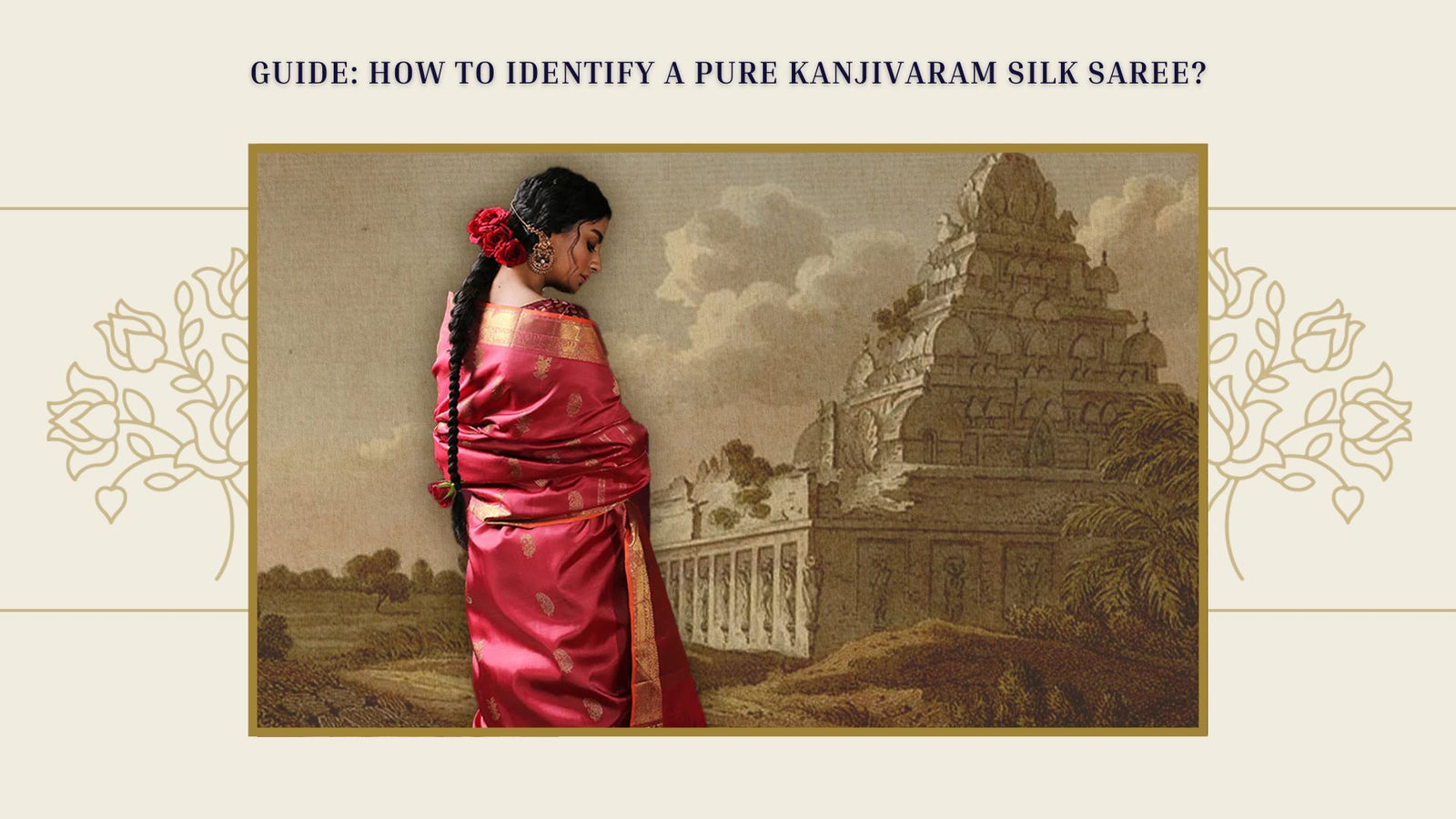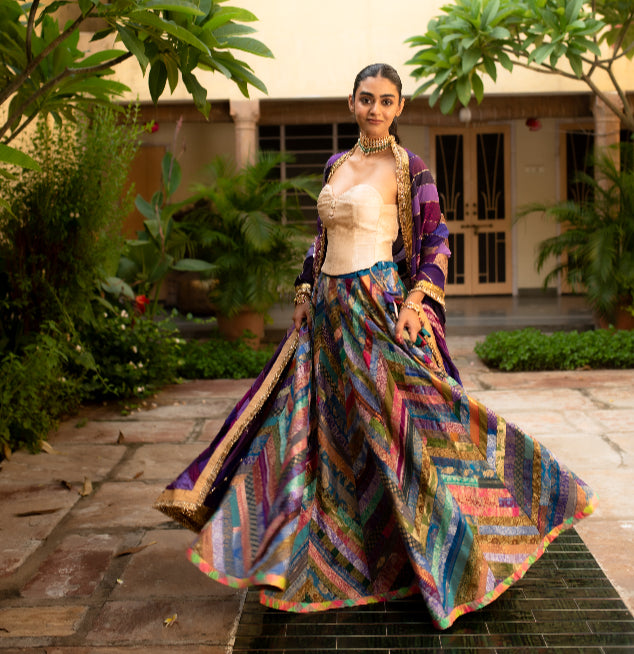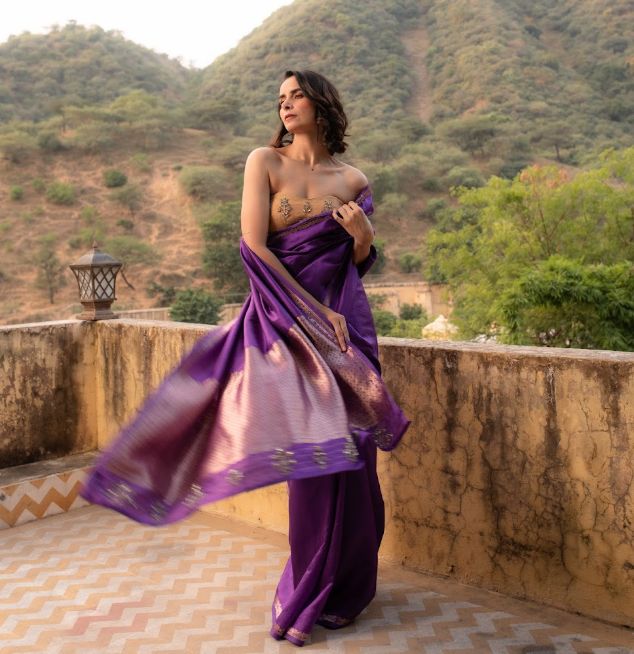Guide: How to Identify a Pure Kanjivaram Silk Saree?

Introduction to Kanjivaram Silk Saree
“A Kanjivaram saree is not just a garment; it’s a piece of art.” This quote captures the essence of Kanjivaram silk sarees, which are celebrated for their luxurious texture and intricate designs. If you’re a saree enthusiast or a budding fashionista, understanding the allure of Kanjivaram silk sarees is a must.
These sarees, often referred to as the queen of silks, are known for their vibrant colours, elaborate patterns, and rich heritage. In this guide, we’ll explore how to identify a pure Kanjivaram silk saree and provide tips to help you choose the best designs.
History of Kanjivaram Silk Saree

Kanjivaram silk sarees hail from the town of Kanchipuram in Tamil Nadu, India. The tradition of weaving these sarees dates back over 400 years, originating during the reign of the Chola Dynasty. The artisans of Kanchipuram are renowned for their skill and dedication to maintaining the highest quality standards.
Each saree is woven with a double warp and weft, using pure mulberry silk threads and zari made from gold and silver. The result is a durable, opulent fabric that has become a symbol of elegance and prestige.
Also Check : How to Choose a Pure Banarasi Silk Saree
How to Identify an Authentic Kanjivaram Silk Saree?

Identifying a pure Kanjivaram silk saree can be challenging, especially with many imitations flooding the market. Here are some key factors to look out for:
1. Texture and Weight
Pure Kanjivaram silk sarees are heavier compared to other silk sarees due to the quality of silk and the use of zari. The texture should feel smooth and luxurious.
2. Zari Work:
Authentic Kanjivaram sarees feature real zari, which is made by dipping silk threads in silver and then gold. A simple way to check if the zari is genuine is by gently scratching it; if it's real, you'll see a red silk thread underneath.
On the other hand, fake zari often uses threads made of plastic or copper. The copper threads are typically plated with silver and sometimes even gold, but they're not the same as the real deal.
3. Price Point:
Pure Kanjivaram silk sarees can be quite pricey due to the quality of materials and the expert craftsmanship that goes into making them. So, if you come across one at a much lower price, it’s wise to be a bit sceptical.
For reference, a pure Kanjivaram saree typically ranges from around INR 10,000 to INR 50,000 or even more, depending on the intricacy of the design and the zari work.
4. Design and Patterns:
Kanjivaram sarees traditionally showcase designs inspired by temples, nature, and mythological stories. You'll often find intricate patterns and motifs, such as peacocks, elephants, and floral designs.
5. Weaving Technique:
The double-warp and double-weft technique is unique to Kanjivaram sarees. This method not only adds durability but also allows for complex and vibrant designs. Examine the saree closely to check for this distinctive weaving style.
6. Silk Mark Label:
When you're shopping for a saree, it's a good idea to look for the Silk Mark label. This label helps you know that the saree is made from pure silk, ensuring its authenticity and quality.
Also Read : How to Choose the Best Bridal Lehenga
Tips to Select Perfect Kanjivaram Silk Saree

Choosing the perfect Kanjivaram silk saree involves more than just identifying authenticity. Here are some tips to help you make the best choice:
1. Consider the Occasion:
Kanjivaram silk sarees are ideal for weddings, festivals, and other grand events. For weddings, opt for vibrant colours like red, maroon, and gold. For festivals, you might prefer lighter colours and simpler designs.
2. Match with Your Jewellery:
Since Kanjivaram sarees are rich and elaborate, pair them with traditional gold jewellery. Antique and temple jewellery work wonderfully with these sarees, enhancing the overall look.
3. Choose the Right Colour:
The colour of the saree should complement your skin tone. While traditional colours are always in vogue, don’t hesitate to explore contemporary shades like pastels, deep blues, and greens.
4. Pay Attention to the Border:
The border design can significantly impact the saree’s look. Broad borders with heavy zari work are traditional, but if you prefer a modern touch, opt for medium or narrow borders with subtle designs.
5. Maintenance and Care:
Kanjivaram silk sarees require careful maintenance. Dry clean them to preserve the zari and fabric quality. Store them in a cool, dry place, preferably wrapped in muslin cloth to prevent damage.
Conclusion:
Kanjivaram silk sarees are not just garments; they are timeless pieces of heritage and art. Learning to identify a pure Kanjivaram silk saree helps you make a lasting investment. Whether you're picking one for a special occasion or adding it to your collection, a Kanjivaram saree is a must-have that radiates elegance and tradition. It's the kind of piece that truly belongs in every wardrobe.
FAQs
Q1. What is special about Kanjivaram silk sarees?
Ans. Kanjivaram silk sarees are renowned for their rich texture, vibrant colours, and intricate designs. They are made from high-quality mulberry silk and real gold or silver zari, making them durable and luxurious.
Q2. How can I test the purity of a Kanjivaram silk saree?
Ans. To test the purity of a Kanjivaram silk saree, look for the Silk Mark label, check the weight and texture, and examine the zari work. Genuine zari will reveal a red silk thread when gently scratched.
Q3. Why are Kanjivaram sarees expensive?
Ans. Kanjivaram sarees are expensive due to the high-quality materials used, including pure mulberry silk and real gold or silver zari, and the intricate craftsmanship involved in weaving these sarees.
Q4. Can Kanjivaram silk sarees be worn for casual occasions?
Ans. While Kanjivaram silk sarees are typically worn for grand events like weddings and festivals, lighter designs and colours can be chosen for more casual or semi-formal occasions.
Q5. How should I store my Kanjivaram silk saree?
Ans. To keep your Kanjivaram silk saree in great condition, try storing it in a cool, dry place, wrapped in a muslin cloth. It's best to avoid using plastic covers since they can trap moisture.
Make sure to have the saree dry cleaned and store it away from direct sunlight to help maintain its quality. You can also add neem leaves to protect it from insects, and gently roll the saree when storing to prevent creases.

